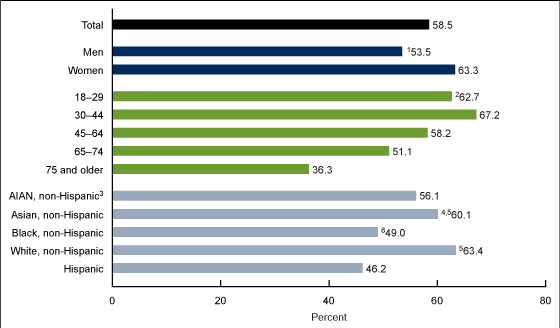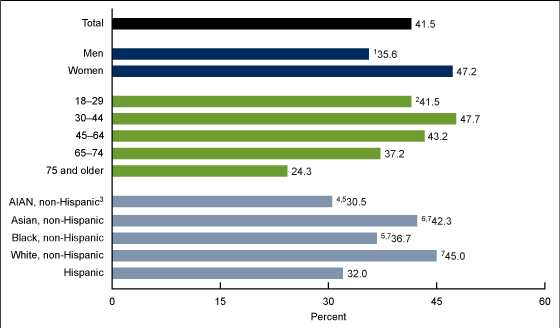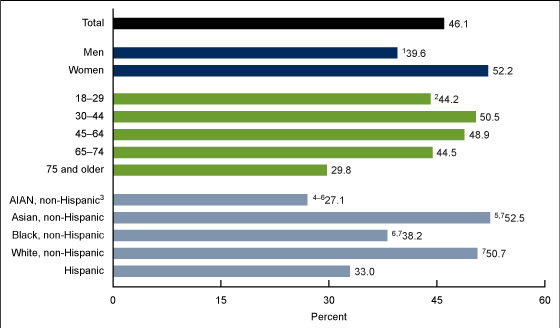Health Information Technology Use Among Adults: United States, July–December 2022
NCHS Data Brief No. 482, October 2023
PDF Version (462 KB)
Xun Wang, M.S., and Robin A. Cohen, Ph.D.
- Key findings
- Women were more likely than men to have used the Internet to look for health or medical information in the past 12 months.
- Adults ages 30–44 were the most likely to have used the Internet to communicate with a doctor or doctor’s office.
- Asian and White adults were more likely to have used the Internet to look up medical test results compared with American Indian and Alaska Native, Black, and Hispanic adults.
- Summary
Data from the National Health Interview Survey
- During July–December 2022, 58.5% of adults used the Internet to look for health or medical information, with a higher prevalence observed among women compared with men.
- Using the Internet to communicate with a doctor or doctor’s office was highest among adults ages 30–44 (47.7%), followed by a decline with increasing age.
- Among adults who used the Internet to look up medical test results, Asian non-Hispanic and White non-Hispanic adults were more likely to look up medical test results compared with American Indian and Alaska Native non-Hispanic, Black non-Hispanic, and Hispanic adults.
Health information technology (HIT) is the use of electronic systems to store, share, and analyze health information and is considered separately from telehealth, which is the use of medical and telecommunications technology to provide direct patient care (1,2). The focus of this report includes three components of HIT: using the Internet to look for health or medical information, communicating with a doctor (but not to receive direct care), and looking up medical test results (3,4). Data on Internet access and HIT use were collected as part of the National Health Interview Survey (NHIS) from July–December 2022. This report describes the percentage of adults who had Internet access and had used any of the three selected HIT components in the past 12 months by sex, age, and race and Hispanic origin.
Keywords: Internet, communication, test results, National Health Interview Survey
Women were more likely than men to have used the Internet to look for health or medical information in the past 12 months.
- During July–December 2022, 58.5% of adults had used the Internet in the past 12 months to look for health or medical information (Figure 1).
- Women (63.3%) were more likely than men (53.5%) to have used the Internet to look for health or medical information.
- The percentage of adults who used the Internet to look for health or medical information increased from 62.7% among adults ages 18–29 to 67.2% among adults ages 30–44, and then subsequently decreased with increasing age to 36.3% among adults ages 75 and older.
- The percentage of adults who used the Internet to look for health or medical information was higher among White non-Hispanic (subsequently, White) (63.4%) and Asian non-Hispanic (subsequently, Asian) (60.1%) adults compared with Black non-Hispanic (subsequently, Black) (49.0%) and Hispanic (46.2%) adults. The percentage of American Indian and Alaska Native non-Hispanic (subsequently, American Indian and Alaska Native) adults who used the Internet to look for health or medical information (56.1%) was not significantly different from use among White, Asian, Black, and Hispanic adults.
Figure 1. Percentage of adults who used the Internet in the past 12 months to look for health or medical information, by sex, age, and race and Hispanic origin: United States, July–December 2022

1Significantly different from women (p < 0.05).
2Significant quadratic trend with age (p < 0.05).
3AIAN is American Indian and Alaska Native.
4Significantly different from Black non-Hispanic adults (p < 0.05).
5Significantly different from Hispanic adults (p < 0.05).
6Significantly different from White non-Hispanic adults (p < 0.05).
NOTES: Estimates are based on “yes” responses to the option, “To look for health or medical information,” when asked the question, “During the past 12 months, have you used the Internet for any of the following reasons?” Adults who did not use the Internet were counted as not looking up health or medical information. Adults of Hispanic origin may be of any race. Adults of other and multiple races are not shown. Estimates are based on household interviews of a sample of the U.S. civilian noninstitutionalized population. Access data table for Figure 1.
SOURCE: National Center for Health Statistics, National Health Interview Survey, 2022.
Adults ages 30–44 were the most likely to have used the Internet to communicate with a doctor or doctor’s office.
- During July–December 2022, 41.5% of adults had used the Internet in the past 12 months to communicate with a doctor or doctor’s office (Figure 2).
- Women (47.2%) were more likely than men (35.6%) to have used the Internet to communicate with a doctor or doctor’s office.
- The percentage of adults who used the Internet to communicate with a doctor or doctor’s office increased from 41.5% among adults ages 18–29 to 47.7% among adults ages 30–44, and then subsequently decreased with increasing age to 24.3% among adults ages 75 and older.
- The percentage of adults who used the Internet to communicate with a doctor or doctor’s office was higher among White (45.0%) and Asian (42.3%) adults compared with Black (36.7%), Hispanic (32.0%), and American Indian and Alaska Native (30.5%) adults. Black adults were more likely than Hispanic adults to have used the Internet to communicate with a doctor or doctor’s office.
Figure 2. Percentage of adults who used the Internet in the past 12 months to communicate with a doctor or doctor’s office, by sex, age, and race and Hispanic origin: United States, July–December 2022

1Significantly different from women (p < 0.05).
2Significant quadratic trend with age (p < 0.05).
3AIAN is American Indian and Alaska Native.
4Significantly different from Asian non-Hispanic adults (p < 0.05).
5Significantly different from White non-Hispanic adults (p < 0.05).
6Significantly different from Black non-Hispanic adults (p < 0.05).
7Significantly different from Hispanic adults (p < 0.05).
NOTES: Estimates are based on “yes” responses to the option, “To communicate with a doctor or doctor’s office,” when asked the question, “During the past 12 months, have you used the Internet for any of the following reasons?” Adults who did not use the Internet were counted as not communicating with a doctor or doctor’s office. Adults of Hispanic origin may be of any race. Adults of other and multiple races are not shown. Estimates are based on household interviews of a sample of the U.S. civilian noninstitutionalized population. Access data table for Figure 2.
SOURCE: National Center for Health Statistics, National Health Interview Survey, 2022.
Asian and White adults were more likely to have used the Internet to look up medical test results compared with American Indian and Alaska Native, Black, and Hispanic adults.
- During July–December 2022, 46.1% of adults had used the Internet in the past 12 months to look up medical test results (Figure 3).
- Women (52.2%) were more likely than men (39.6%) to have used the Internet to look up medical test results.
- The percentage of adults who used the Internet to look up medical test results increased from 44.2% among adults ages 18–29 to 50.5% among adults ages 30–44, and then subsequently decreased with increasing age to 29.8% among adults ages 75 and older.
- The percentage of adults who used the Internet to look up medical test results was higher among Asian (52.5%) and White (50.7%) adults compared with Black (38.2%), Hispanic (33.0%), and American Indian and Alaska Native (27.1%) adults. Black adults were more likely than Hispanic and American Indian and Alaska Native adults to have looked up medical tests using the Internet.
Figure 3. Percentage of adults who used the Internet in the past 12 months to look up medical test results, by sex, age, and race and Hispanic origin: United States, July–December 2022

1Significantly different from women (p < 0.05).
2Significant quadratic trend with age (p < 0.05).
3AIAN is American Indian and Alaska Native.
4Significantly different from Asian non-Hispanic adults (p < 0.05).
5Significantly different from Black non-Hispanic adults (p < 0.05).
6Significantly different from White non-Hispanic adults (p < 0.05).
7Significantly different from Hispanic adults (p < 0.05).
NOTES: Estimates are based on “yes” responses to the option, “To look up medical test results,” when asked the question, “During the past 12 months, have you used the Internet for any of the following reasons?” Adults who did not use the Internet were counted as not looking up medical test results. Adults of Hispanic origin may be of any race. Adults of other and multiple races are not shown. Estimates are based on household interviews of a sample of the U.S. civilian noninstitutionalized population. Access data table for Figure 3.
SOURCE: National Center for Health Statistics, National Health Interview Survey, 2022.
Summary
During July–December 2022, 58.5% of U.S. adults used the Internet to look for health or medical information, 41.5% used it to communicate with a doctor or doctor’s office, and 46.1% used it to look up medical test results. Women showed a higher likelihood of having used HIT compared with men. Adults ages 30–44 showed the highest rates of HIT usage, with a subsequent decline observed as age increased. Variation was also seen in HIT usage across race and Hispanic-origin groups. Asian and White adults had higher rates of HIT use compared with Black and Hispanic adults. NHIS results in this report align with recent findings from the Health Information National Trends Survey (5), which found similar variations in HIT usage by sex, age, and race and Hispanic origin.
Definitions
Health information technology (HIT) use: Estimates for each selected HIT measure were based on positive responses to the following questions: “During the past 12 months, have you used the Internet for any of the following reasons? To look for health or medical information,” “During the past 12 months, have you used the Internet for any of the following reasons? To communicate with a doctor or doctor’s office,” and “During the past 12 months, have you used the Internet for any of the following reasons? To look up medical test results.” These questions were only asked of the 93.3% of adults who had access to the Internet. Adults who did not have access to the Internet were considered to not have used HIT and are included in the estimates’ denominators.
Race and Hispanic origin: Adults categorized as Hispanic may be of any race or combination of races. Adults categorized as non-Hispanic indicated one race only. Other and multiple races include those who did not identify as American Indian and Alaska Native, Asian, Black, Hispanic, or White, and those who identified as more than one race, are not shown.
Data source and methods
This analysis was limited to data from the July–December 2022 NHIS, as questions related to Internet access and HIT use among adults were fielded beginning in the third quarter of 2022. Estimates were based on a sample of 14,020 adults ages 18 and older. NHIS is a nationally representative household survey of the U.S. civilian noninstitutionalized population. It is conducted continuously throughout the year by the National Center for Health Statistics. Interviews are typically conducted in respondents’ homes, but follow-ups to complete interviews may be conducted over the telephone. For more information about NHIS, visit: https://www.cdc.gov/nchs/nhis/.
Point estimates and corresponding confidence intervals were calculated using SAS-callable SUDAAN software (6) to account for the complex sample design of NHIS. Differences between percentages were evaluated using two-sided significant tests at the 0.05 level. Tests for trends were evaluated using logistic regression. All estimates in this report meet National Center for Health Statistics standards of reliability as specified in “National Center for Health Statistics Data Presentation Standards for Proportions” (7).
About the authors
Xun Wang and Robin A. Cohen are with the National Center for Health Statistics, Division of Health Interview Statistics.
References
- Department of Health and Human Services. What is telehealth. 2023.
- The Office of the National Coordinator for Health Information Technology. Health IT: Advancing America’s health care.
- Onyeaka HK, Romero P, Healy BC, Celano CM. Age differences in the use of health information technology among adults in the United States: An analysis of the Health Information National Trends Survey. J Aging Health 33(1–2):147–54. 2021.
- Rajamani G, Kurina L, Rosas LG. Investigating health information technology usage by sociodemographic subpopulations to increase community engagement in healthcare: An analysis of the Health Information National Trends Survey. AMIA Annu Symp Proc 1029–38. 2022.
- National Cancer Institute. Health Information National Trends Survey: Disparities in patient portal communication, access, and use. Hints Briefs, no 52. 2023.
- RTI International. SUDAAN (Release 11.0.3) [computer software]. 2018.
- Parker JD, Talih M, Malec DJ, Beresovsky V, Carroll M, Gonzalez JF Jr, et al. National Center for Health Statistics data presentation standards for proportions. National Center for Health Statistics. Vital Health Stat 2(175). 2017.
Suggested citation
Wang X, Cohen RA. Health information technology use among adults: United States, July–December 2022. NCHS Data Brief, no 482. Hyattsville, MD: National Center for Health Statistics. 2023. DOI: https://dx.doi.org/10.15620/cdc:133700.
Copyright information
All material appearing in this report is in the public domain and may be reproduced or copied without permission; citation as to source, however, is appreciated.
National Center for Health Statistics
Brian C. Moyer, Ph.D., Director
Amy M. Branum, Ph.D., Associate Director for Science
Division of Health Interview Statistics
Stephen J. Blumberg, Ph.D., Director
Anjel Vahratian, Ph.D., M.P.H., Associate Director for Science